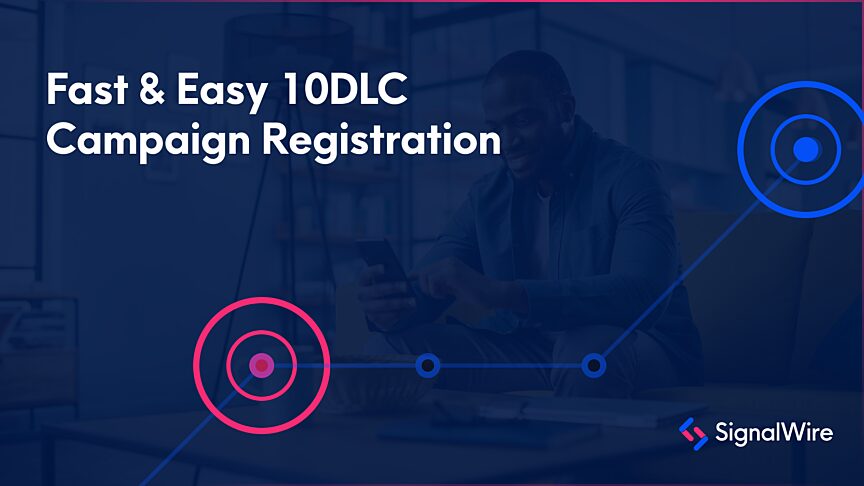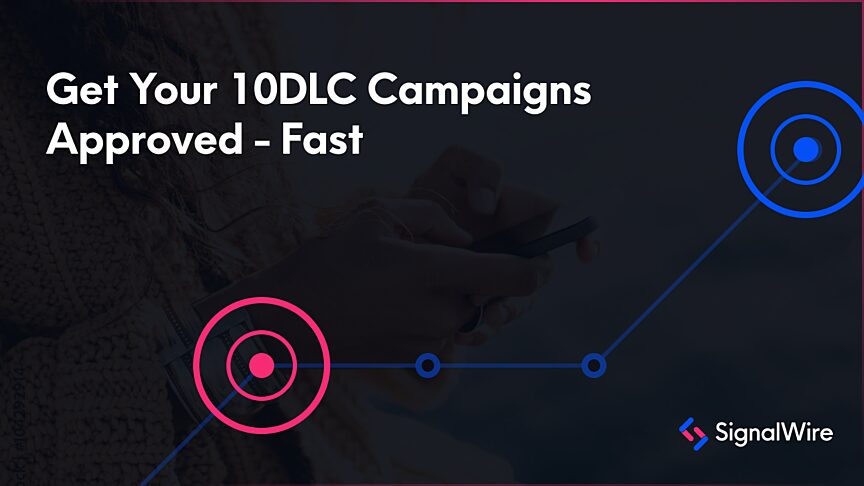When it comes to The Campaign Registry (TCR), SignalWire has been at the forefront of the registration process from the beginning. We have plenty of resources to get you started, loads of tips for getting registered quickly, guidance on increasing your deliverability, and an incredibly knowledgeable team who will answer any questions you have or meet with you to discuss the specifics of your campaign.
In our recent LiveWire, our Carrier Operations Manager, Kat, goes over these details and answers a variety of live questions around the topic.
SignalWire is a great choice for your Campaign Service Provider (CSP) because we make it extremely easy to get registered successfully. Our TCR wizard is intuitive to use, and we have some detailed guides on optimizing your SMS traffic and getting registered on your first submission.
Don’t worry if you feel lost when dealing with all of the acronyms involved in the A2P 10DLC ecosystem, because we have a glossary for that, too.
What is The Campaign Registry?
TCR is the database where you will register your brand and campaign. Put simply, your brand is the company or entity sending messages, while the campaign is your messaging use case.
This database provides one centralized resource for visibility into who is sending what. Registration is required by U.S. Mobile Network Operators (MNOs - think AT&T, T-Mobile, Verizon, etc.) in order to fight spam and scams while giving these wireless carriers insight into who is using their networks.
To give some context for why creating TCR was necessary, consider that over 10 billion spam texts were sent in February 2023 (down from 55 billion in December 2022!), according to a report by Robokiller. That averages out to 39 spam texts a month per person.
Registering with TCR works out well for everyone involved. It cuts down on spam and scam messages for end users, but it’s also good for your business. With TCR, you can increase your deliverability, throughput, and trust in your brand. You’ll encounter hefty fees and halted traffic if you do not register.
TCR is not for short codes or toll free numbers. This is the registry specifically for 10 digit long code (10DLC) phone numbers. With 10DLC, you have a higher throughput depending on your messaging use case, and SignalWire will queue and throttle your messages for you.
If you’re wondering about other types of phone numbers such as toll free, you should know that at this time, toll free registration is even more manual and time consuming than TCR, with wait times of up to 8 weeks. Expect to wait 3-5 business days when registering with TCR.
Once you register your brand and campaign, a CSP like SignalWire handles the process for you. We vet the campaign and push the connection request upstream to a Direct Connect Aggregator (DCA). Once it is accepted there, you will be ready to start sending out messages. You can read more about that process in our introductory article about TCR.
10DLC regulations are always evolving
Recently, larger providers have gotten stricter with unregistered campaigns. You’ll find yourself racking up extra fees for unregistered or unsanctioned traffic.
SignalWire understood that deliverability would be affected as soon as TCR was announced years ago, and we’ve worked with our industry contacts every step of the way to get the best results possible for our customers. We have been following regulations and integrating TCR registration into our messaging practices for over a year now. You can trust us to vet your registrations thoroughly and do what we can to get you ready to send messages as quickly as possible.
We won't let you register low quality campaigns. Our traffic experts personally vet applications prior to registration to prevent unnecessary delays or re-vetting fees. We may reach out to you about your campaign if we don’t think it will be accepted further in the process. We follow industry-wide messaging best practices and we have a clean traffic record, with an excellent relationship to our upstream peers, which helps us resolve issues faster.
The registration process with SignalWire
To get started with TCR, you’ll submit your brand and campaign to us through our TCR wizard, and we will review it. To prepare for this step, you will need the following:
An informative campaign description of at least 40 characters
A valid website for your brand
Opt-in process and opt-out language
Accurate sample messages
Help messages
If you want more details or example messages, our Carrier Operations team put together a great guide on registration tips.
Once SignalWire has reviewed the campaign, a DCA is responsible for vetting new registrations and allowing traffic to traverse their network. The DCA will decide if the registration is acceptable and compliant. Once the DCA is done vetting, your campaign is ready to begin sending messages.
Turnaround times vary, but SignalWire is much quicker than other CSPs. Other providers have been reporting a DCA vetting turnaround time of up to a week of more. SignalWire is still seeing turnaround times ranging from a few hours to two business days because we provide our DCA with quality registrations.
DCA vetting is often the biggest hurdle, so we want to make sure you're prepared from the start. Our experts will offer you advice if needed. Our DCA charges a $15 fee per each vetting submission, so we will do everything we can to get you accepted on your first submission. As you use our wizard, you can open a ticket at any time to ask our team questions.
Common mistakes and best practices
Often missed by first time registrants:
Make sure you have a valid website associated with your brand.
Your opt-out language might not be good enough, or is or not included in all sample messages. Though not required in every message you send, opt-out language is required in every sample.
Sample messages must be accurate and fit your description.
Have a good help message to show you're working with subscribers if they do need assistance.
SignalWire’s words of advice:
Be sure to collect and maintain valid opt-in consent.
Do not spam or annoy your subscribers. 4 messages or fewer per month is good practice.
Include branding in your messages so subscribers know who is contacting them.
Do not use public URL shorteners (bit.ly, goo.gl).
If you need to change your message templates at any time, open a ticket and we can do that for you.
If you get a lot of complaints from subscribers, mobile carriers could investigate your registration. They can also block you at any time if you’re being inappropriate or spammy, even if you’re registered. Following our advice will maximize your deliverability.
Increasing 10DLC throughput
Throughput is calculated and sent at the campaign level, not at the individual number level. Using more phone numbers will not work to evade spam filters or increase your throughput.
Throughput varies by carrier. T-Mobile, for instance, handles throughput a little differently with a daily limit at brand level. Per T-Mobile’s default, standard use cases start at 2,000 messages per day with a throughput of 4 messages per second. AT&T and Verizon do not have daily limits on messages to subscribers, but AT&T sets one for per-second throughput.
You can increase daily throughput using brand vetting. This is optional, but can be very useful, especially with carriers like T-Mobile. It costs $40 per vet, and is unrelated to the $15 vetting fee for the campaign. Our specialists can easily submit your vetting request - just open a ticket and we can get you set up.
If you choose to get brand vetting, you will receive a vetting score between 1-100. Higher scores increase your throughput.
Score: 1-24
The standard throughput remains 4 messages per second per campaign, and the daily T-Mobile brand cap is 2,000.
Score: 25-49
The standard throughput is 4 messages per second per campaign, and the daily T-Mobile brand cap is increased to 10,000.
Score: 50-74
The standard throughput increases to 40 messages per second per campaign, and the daily T-Mobile brand cap is increased to 40,000.
Score: 75-100
The standard throughput increases to 75 messages per second per campaign, and the daily T-Mobile brand cap is increased to 200,000.
Campaign Registry Pricing
$4 | one-time brand registration |
$1.50-$10 monthly (first 3 months upfront) | recurring monthly charge for campaign registration, with the first 3 months charged upfront. Price varies by use case. |
$7.50 | one-time DCA vetting fee (charged by the DCA, not TCR) |
TOTAL = $16 - $42 |
Check out our pricing page for the most up to date and accurate information on costs related to SMS traffic.
Your first TCR registration fee is on us! When you choose SignalWire as your CSP, we’ll cover the fees for one campaign up to $45. Contact support@signalwire.com to get this deal.
Inactivity Warning
T-Mobile has had an issue with people abusing the registration process, and have begun charging a $250 fee for inactive campaigns. To avoid this, be sure to have an active number assigned to each of your campaigns, and send at least one message to a T-Mobile handset every 59 days!
We are here if you need help
Although you can open a ticket at any time, if you have questions, we have a few other resources where you can find us! Check out our Community Slack or our Forum. Get started for free today with our messaging platform free trial.


